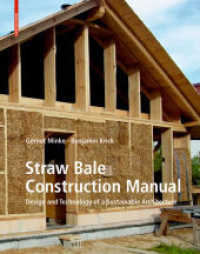- ホーム
- > 洋書
- > 英文書
- > Computer / General
Full Description
It is with great pleasure that I present this fourth vol ume in the series "Advanced Applications in Pattern Recognition." It would be difficult to find two authors better versed in the design and application of parallel image processing systems, due to both their own many years of pioneering in the field and their encyclopedic knowledge of what is going on in uni versity and industrial laboratories around the world. The monograph is unique in its parallel presentation of orthogonal and hexagonal dissections, and the wealth of graphic illustration of algorithmic procedures for processing and analyz ing images in the various known implementations of parallel im age-processing architectures. This volume should find a place on the bookshelf of every practitioner of pattern recognition, image processing, and compu ter graphics. Morton Nadler General Editor vii PREFACE This book endeavors to introduce the reader to the subject of cellular logic and cellular automata and is devoted particu larly to those parts dealing with the manipulation of pictorial data. The study of cellular automata owes much to the pioneer ing work of John von Neumann during the 1950s. Von Neumann was interested in general problems in the behavior of computing structures and was immensely impressed by the complexity and performance of the human brain, which he felt must point to wards successful designs for automatic computing machines.
Contents
1. Introduction.- 2. Two-Dimensional Logical Transforms.- 3. Cellular Logic Operations in N-Space.- 4. Numerical Operations.- 5. Segmentation.- 6. Skeletonization.- 7. Cellular Filtering.- 8. Scientific Applications.- 9. Biomedical Applications.- 10. Cellular Logic Machines.- 11. Array Automata.- 12. Patterns of Growth.- 13. Programming Methods.- 14. Fabrication Methods.- References.- Author Index.








